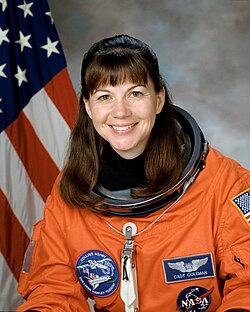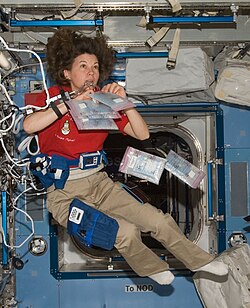Catherine Colemanová
| Catherine Grace Colemanová | |
|---|---|
 | |
| Astronaut NASA | |
| Státní příslušnost | USA |
| Datum narození | 14. prosince 1960 (64 let) |
| Místo narození | Charleston, Jižní Karolína, USA |
| Předchozí zaměstnání | chemička letectva USA |
| Hodnost | plukovník letectva |
| Čas ve vesmíru | 180 dní, 4 hodiny, 0 minut |
| Kosmonautka od | 31. března 1992 |
| Mise | STS-73, STS-93, Expedice 26/27 (Sojuz TMA-20/ISS) |
| Znaky misí | |
| Kosmonautka do | 24. května 2011 |
| Některá data mohou pocházet z datové položky. | |
Catherine Grace Colemanová (* 14. prosince 1960, Charleston, Jižní Karolína, USA), původně odbornice na chemii v letectvu Spojených států, je od března 1992 astronautkou NASA. Má za sebou dva krátkodobé kosmické lety v Space Shuttlu při misích STS-73 a STS-93. Od roku 2008 se připravovala na dlouhodobý pobyt na Mezinárodní vesmírné stanici (ISS) jako členka Expedic 26 a 27, do kosmu odstartovala 15. prosince 2010 a přistála 24. května 2011.[1] Celkem při třech letech strávila ve vesmíru 180 dní a 4 hodiny.
Život
Mládí
Narodila se v Charlestonu v Jižní Karolíně. Roku 1978 dokončila střední školu ve Fairfaxu v Západní Virginii. Poté studovala chemii na Massachusettském institutu technologie (Massachusetts Institute of Technology), roku 1983 zde získala titul bakaláře. Roku 1983 byla přijata k vojenskému letectvu, ale zatím pokračovala ve studiích na Massachusettské univerzitě (University of Massachusetts) na které roku 1991 dosáhla doktorské hodnosti.[2]
Až od roku 1988 sloužila v letectvu na základně Wright-Patterson AFB. V tamějších laboratořích se podílela na vývoji polymerů určených pro optické počítačové paměti. Účastnila se též analýz stavu povrchu platformy (Long Duration Exposure Facility) ponechané 6 let ve vesmíru.[2]
Astronautka
Zúčastnila se 14. náboru astronautů NASA, uspěla a 31. března 1992 byla začleněna do oddílu astronautů NASA. V ročním kurzu všeobecné kosmické přípravy získala kvalifikaci letové specialistky raketoplánu Space Shuttle.[3]

Po dokončení přípravy zastávala různé funkce v NASA. Poprvé do kosmu odstartovala 20. října 1995 na palubě raketoplánu Columbia při letu STS-73. Astronauté prováděli experimenty v laboratoři Spacelab, přistáli 5. listopadu 1995 po 15 dnech, 21 hodinách a 53 minutách pobytu ve vesmíru.[4]
Ve dnech 23.–28. července 1999 pobývala ve vesmíru podruhé. Let STS-93 raketoplánu Columbia trval 4 dní, 22 hodin a 17 minut. Hlavním úkolem mise bylo vypuštění rentgenového teleskopu Chandra. Po splnění letového programu astronauté přistáli na mysu Canaveral.[5]
V lednu 2008 byla jmenována náhradnicí Nicole Stottové v posádce Mezinárodní vesmírné stanice (ISS), Stottová vzlétla k ISS v srpnu 2009. V červenci 2008 byla současně zařazena do záložní posádky Expedice 24 (start v květnu 2010) a hlavní posádky Expedice 26 se startem v listopadu 2010.[3] V září 2008 bylo její jmenování bylo oficiálně potvrzeno.[6]
Ke třetímu letu odstartovala v lodi Sojuz TMA-20 z kosmodromu Bajkonur 15. prosince 2010 v 19:09 UTC ve funkci palubní inženýrky lodi společně s ruským velitelem Dmitrijem Kondraťjevem a Italem Paolo Nespolim. Po obvyklém dvoudenním letu se 17. prosince Sojuz spojil s Mezinárodní vesmírnou stanicí.[7] Na ISS zůstala přes pět měsíců ve funkci palubní inženýrky Expedic 26 a 27. Vrátila se v Sojuzu TMA-20 s Kondraťjevem a Nespolim. Přistáli 24. května 2011 v 2:27 UTC v Kazachstánu,[7] 147 km východně od Džezkazganu.
Catherine Colemanová je vdaná za uměleckého skláře Joshe Simpsona.[2]
Odkazy
Reference
- ↑ Catherine "Cady" Coleman [online]. 2016-12-01 [cit. 2025-02-23]. Dostupné online.
- ↑ a b c Biographical data. Catherine Coleman, Ph.D. (Colonel, USAF) [online]. Houston: NASA, rev. 2008-09 [cit. 2010-01-09]. Dostupné v archivu pořízeném dne 2010-12-13. (anglicky) – Oficiální biografie NASA
- ↑ a b IVANOV, Ivan, a kol. Космическая энциклопедия ASTROnote [online]. Moskva: rev. 2009-10-13 [cit. 2009-10-20]. Kapitola Catherine Grace «Cody» Coleman. Dostupné online. (rusky)
- ↑ HOLUB, Aleš. MEK. Malá encyklopedie kosmonautiky [online]. Rev. 1997-02-27 [cit. 2009-10-20]. Kapitola STS-73 Co/F-18. [dále jen Holub]. Dostupné online.
- ↑ Holub. Rev. 1999-08-03 [cit. 2009-10-20]. Kapitola STS-93 Co/F-26.
- ↑ Пресс-служба Роскосмоса. Предварительный план-график экспедиций на МКС и смен экипажа на кораблях «Союз» (с июня 2008г. по ноябрь 2010г.) [online]. Moskva: Roskosmos, 2008-09-21 [cit. 2009-10-15]. Dostupné online. (rusky)[nedostupný zdroj]
- ↑ a b HOLUB, Aleš. MEK. Malá encyklopedie kosmonautiky [online]. Praha: rev. 2010-12-17 [cit. 2010-12-20]. Kapitola Sojuz TMA-20. Dostupné online.
Externí odkazy
 Obrázky, zvuky či videa k tématu Catherine Colemanová na Wikimedia Commons
Obrázky, zvuky či videa k tématu Catherine Colemanová na Wikimedia Commons - Astronaut at a Glance: Catherine Coleman
Média použitá na této stránce
In the foreground of the patch, the International Space Station is prominently displayed to acknowledge the efforts of the entire International Space Station (ISS) team - both the crews who have built and operated it, and the team of scientists, engineers, and support personnel on Earth who have provided a foundation for each successful mission. Their efforts and accomplishments have demonstrated the space station's capabilities as a technology test bed and a science laboratory, as well as a path to the human exploration of our solar system and beyond. The ISS is shown with the European Space Agency's (ESA) Automated Transfer Vehicle (ATV-2), the Johannes Kepler, docked to resupply it with experiments, food, water, and fuel for Expedition 26 and beyond. This Expedition 26 patch represents the teamwork among the international partners - USA, Russia, Japan, Canada, and the ESA - and the ongoing commitment from each partner to build, improve, and utilize the ISS. Prominently displayed in the background is our home planet, Earth - the focus of much of our exploration and research on our outpost in space. The two stars symbolize two Soyuz spacecraft, each one carrying a three-member crew, who for four months will work and live together aboard the ISS as Expedition 26. The patch shows the crewmembers' names, and it's framed with the flags of their countries of origin - United States, Russia, and Italy.
The Expedition 27 patch depicts the International Space Station (ISS) prominently orbiting Earth, continuing its mission for science, technology and education. The ISS is an ever-present reminder of the cooperation between the United States, Russia, Japan, Canada, and the European Space Agency (ESA) – and of the scientific, technical, and cultural achievements that have resulted from that unique teamwork. The ISS is shown in its completed status with the latest addition of the Alpha Magnetic Spectrometer (AMS), and with two resupply vehicles docked at each end of the station. The Southern Cross Constellation is also show in the foreground and its five stars, along with the sun, symbolize the six international crew members that live and work on the space station. The Southern Cross is one of the smallest modern constellations, and also one of the most distinctive. It has cultural significance all over the world and inspires teams to push the boundaries of their worlds, both in space and on the ground.
The crew patch of STS-73, the second flight of the United States Microgravity Laboratory (USML-2), depicts the Space Shuttle Columbia in the vastness of space. In the foreground are the classic regular polyhedrons that were investigated by Plato and later Euclid. The Pythagoreans were also fascinated by the symmetrical three-dimensional objects whose sides are the same regular polygon. The tetrahedron, the cube, the octahedron, and the icosahedron were each associated with the Natural Elements of that time: fire (on this mission represented as combustion science); Earth (crystallography), air and water (fluid physics). An additional icon shown as the infinity symbol was added to further convey the discipline of fluid mechanics. The shape of the emblem represents a fifth polyhedron, a dodecahedron, which the Pythagoreans thought corresponded to a fifth element that represented the cosmos.
Astronaut Catherine G. Coleman, mission specialist
STS093 (S)-001 (Sept. 1998) --- The STS-93 mission patch, as designed by the five crew members. The STS-93 mission will carry the Advanced X-ray Astrophysics Facility (AXAF) into low Earth orbit initiating its planned five-year astronomy mission. AXAF is the third of NASA's great observatories, following the Hubble Space Telescope and the Compton Gamma Ray Observatory. AXAF will provide scientists an order-of-magnitude improvement over current capabilities at X-ray wavelengths. Observations of X-ray emissions from energetic galaxies and clusters, as well as black holes, promise to greatly expand current understanding of the origin and evolution of our universe. The STS-93 patch depicts AXAF separating from the Space Shuttle Columbia after a successful deployment. A spiral galaxy is shown in the background as a possible target for AXAF observations. The two flags represent the international crew, consisting of astronauts from both the United States and France. The NASA insignia design for Shuttle flights is reserved for use by the astronauts and for other official use as the NASA Administrator may authorize. Public availability has been approved only in the form of illustrations by the various news media. When and if there is any change in this policy, which we do not anticipate, it will be publicly announced.
NASA astronaut Catherine (Cady) Coleman, Expedition 26 flight engineer, participates in the ambulatory monitoring part of the Integrated Cardiovascular (ICV) assessment research experiment in the Kibo laboratory of the International Space Station. Coleman is wearing electrodes, a Holter Monitor 2 (HM2) for recording Electrocardiogram (ECG), a European Space Agency (ESA) Cardio pressure / Blood Pressure unit to continuously monitor blood pressure and two Actiwatches (hip/waist and ankle) for monitoring activity levels.





